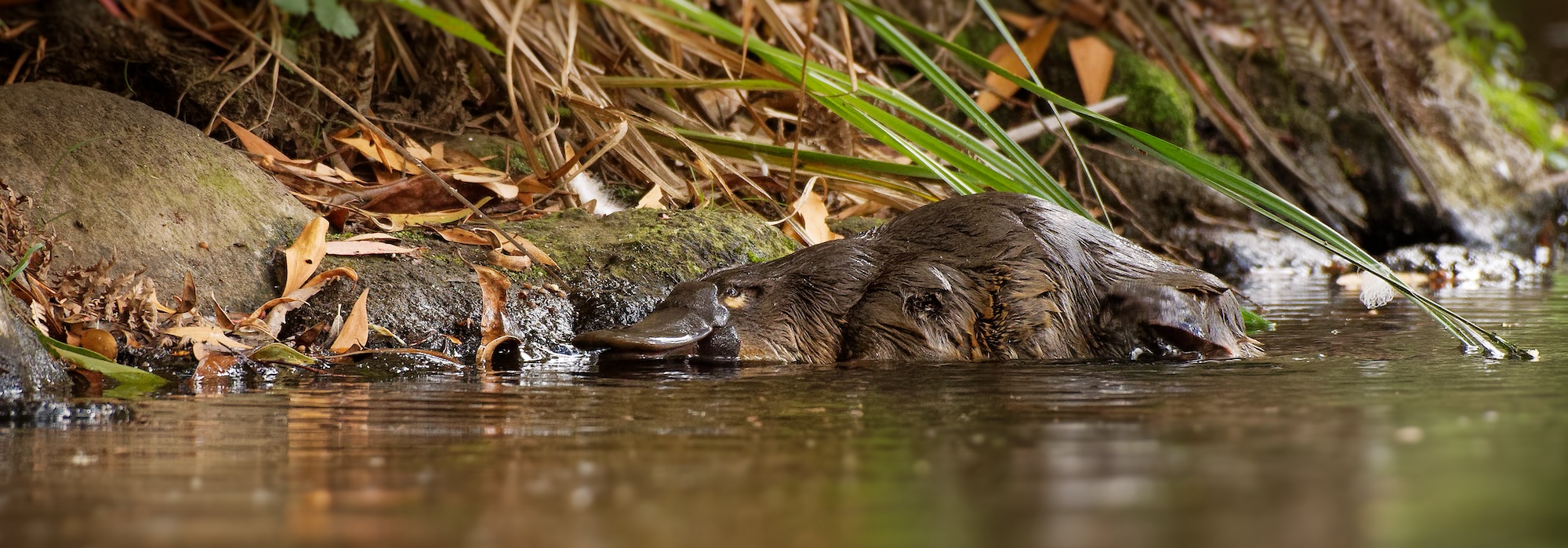
The platypus (Ornithorhynchus anatinus) is one of the world’s most unique animals.
The remarkable platypus!
Picture an animal with the bill of a duck, the fur of an otter and the tail of a beaver – that’s our amazing platypus!
But it doesn’t stop there:
- they are a warm-blooded mammal and feed milk to their young
- they lay eggs like a reptile or bird
- they have electroreceptors in their bill like a shark
- they are venomous like a snake.
Who would think that all these features could be found in the platypus. This makes them one of the most unique creatures on Earth.
Freshwater homes
Platypuses commonly live in the rivers, streams and lakes of eastern Australia, from Queensland to Tasmania. They are excellent swimmers, spending most of their days underwater searching for worms, small shrimp and crayfish and insect larvae.
Although they are not listed as a threatened species in NSW, we don’t know much about where they are living.
Fun facts and features
- Platypuses have a streamlined body and broad, flat tail that is covered with two layers of fur – for insulation and waterproofing. Their fur traps a layer of air next to their skin so they can remain buoyant and dry when they’re underwater.
- The platypus uses its tail for storage of fat reserves.
- Behind its distinctive bill are the grooves that house the ear openings and the eyes which close when the animal dives.
- A platypus bill is flexible, rubbery and feels like suede. It’s used to dig up food from the riverbed. It is also highly sensitive. They use electroreceptors on their bills to detect electrical signals given off by moving prey.
- The strong claws are used for burrowing and moving on land.
- Expert swimmers, platypus use their webbed feet to propel themselves and use their tails to steer through the water.
- Males possess a horny spur on their ankles, which is connected to a venom gland in the upper leg, making the platypus one of the few venomous mammals.
- Despite being a mammal, platypuses lay eggs – making them a monotreme. They also secrete milk to feed their young.
- The platypus spends about 12 hours every day underwater looking for food, 30 to 140 seconds at a time. They eat freshwater shrimp and crayfish, insect larvae and worms.
- Platypus can grow up to 60 cm long and males can weigh 3 kg; females 1.7 kg.
- The name platypus comes from the Greek word for ‘flat-footed’. They’re awkward on land, walking on their knuckles to protect the webbing of their feet.
- The name for a baby platypus is a puggle.
Classroom activities
Build a platypus habitat
What you need
- shoe boxes
- art supplies e.g. clay, paper, cellophane, paint, markers
- materials from the garden e.g. leaves, pebbles, sand, twigs
- reference images of platypus habitats.
Steps
- Discuss where platypus like to live, their preferred habitats. Emphasising features like water bodies, burrows and surrounding vegetation.
- Divide students into small groups and inform them that they will be creating a platypus habitat in a shoebox.
- Encourage students to plan their habitats, considering the layout, elements and materials needed.
- Using the provided materials, students create their platypus habitats inside the shoe boxes.
- Each group presents their habitat, explaining the features they included and why they are important for a platypus’s survival.
Life cycle diagram
What you need
- life cycle diagram activity sheet
- drawing/colouring supplies
Steps
- Watch: A year in the life of one of Earth’s weirdest animals
- Discuss the different stages you noticed in the video.
- Explain the life cycle stages of the platypus, highlighting egg-laying and hatching processes.
- Distribute the activity sheet and guide students to fill in each stage of the platypus life cycle, including egg laying, hatching, growth and adulthood.
- Encourage students to illustrate each stage, emphasising key features or behaviours relevant to that stage.
- Alternatively, have you students create their own drawings of the life cycle stage.
Platypus role-play
Steps
- Watch some videos of platypus. Have your class take note of the way the platypus moves and why it is moving that way.
- Assign different platypus behaviours or activities to groups of students. Groups are going to act out the movements of a platypus doing that behaviour. Allocate one person in each group to be the “David Attenborough” narrator, describing what the ‘platypuses’ in the group are doing.
- Examples include:
- hunting for worms or crustaceans underwater
- digging a burrow to create a nest
- walking on land and over obstacles to get from one waterhole to another
- swimming in the waterhole.
- Allow time for groups to plan and rehearse their role-play scenarios.
- Each group performs their scenarios in front of the class, embodying the behaviours and activities of the platypus.
- After each performance, talk about the behaviours and their significance to a platypus’s life.
Have you seen a monotreme?
- The story celebrates diversity as a platypus journeys along the river, trying to find her place in the animal kingdom.
- Read this story and use some of the fact to help complete the activity sheets.
- Purchase the book
Videos
- A year in the life of one of Earth’s weirdest animals
- Returning the platypus to the Royal National Park
- Platypus monitoring – Melbourne Water
- A little bit about platypus
- Platypus keeper talk at Taronga Zoo
